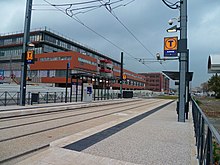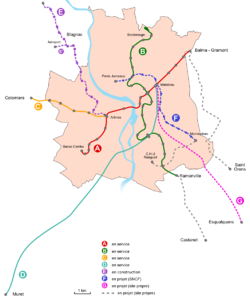Toulouse Metro
| Toulouse Metro | |||
|---|---|---|---|
 | |||
| Overview | |||
| Native name | Métro de Toulouse | ||
| Locale | Toulouse, Midi-Pyrénées, France | ||
| Transit type | Rapid transit | ||
| Number of lines | 3[1] | ||
| Number of stations | 40[1] | ||
| Daily ridership | 281,000 (2011)[2] | ||
| Website | Tisséo | ||
| Operation | |||
| Began operation | June 1993[1] | ||
| Operator(s) | Tisséo | ||
| Technical | |||
| System length | 28.2 km (17.5 mi)[1] | ||
| Track gauge | 1,435 mm (4 ft 8+1⁄2 in) standard gauge | ||
| Electrification | 750 V DC third rail | ||
| |||
The Toulouse Metro (French: Métro de Toulouse) serves the city of Toulouse, France, and some of the surrounding area. The city's public transport system was initially managed by Société d'économie mixte des voyageurs de l'agglomération toulousaine (SEMVAT), which was a company that was 80% owned by local government bodies and 20% privately owned. It has been managed by Tisséo, under the authority of the Syndicat Mixte des Transports en Commun (an authority established by various local government bodies) since 2003.
The Toulouse Metro consists of two primarily underground metro lines, Lines A and B, that together serve 37 stations (38 stations, if the single transfer station between Lines A and B is counted twice),[1] and comprise 28.2 kilometres (17.5 mi) of route.[1] The metro itself is supplemented by Lines C and D, which are suburban rail lines running to the west of the city and to Muret respectively, and by lines T1 (old line E) and T2 which are a tramway to Blagnac's suburbs.
History
- 1983 : City Council decides to create a metro line on a south-western/north-eastern axis.
- 1985 : the municipality decides to use VAL technology.
- 1987 : the project receives planning and environmental approvals.
- 1989 : beginning of work on Line A.
- 1993 : opening of Line A.
- 1997 : beginning of preliminary studies for the extension of Line A and the construction of Line B.
- 2001 : beginning of work on extension of Line A and construction of Line B.
- 2002 : (December) opening of the extension of line A to Balma-Gramont.
- 2007 : (30 June) Opening of Line B, (Borderouge - Ramonville).
- 2010 : Tram Line T1 opens from Arènes to Blagnac
- 2013 : Opening of the extension of Line T1 to Palais de Justice
- 2024 : Date announced for the start of operations of the "Toulouse Aerospace Express" (third metro line)
Network
The Toulouse Metro is currently composed of two lines:[1]
- Line A (12.5 km),[1] Basso-Cambo - Balma Gramont. Opened in 1993,[1] it is mainly underground, but comprises some elevated sections.
- Line B (15.7 km),[1] Borderouge - Ramonville. On a North-South axis, entirely underground and which opened on 30 June 2007.[1]
Lines
Metro: Line A

Line A currently comprises 18 stations[1] on a 12.5 kilometres (7.8 mi) route.[1] The original section of Line A opened in June 1993;[1] an extension from Jolimont to Balma-Gramont opened in 2002.[1] It extends from the shopping centre of Balma through Toulouse with stations at Marengo (connecting with the main SNCF railway station), Capitole, Place Esquirol and University of Mirail. After its final station, Basso-Cambo, is a carriage shed-workshop, which provides storage, maintenance and tests of the rolling stock for the whole of network. The Central Control Centre is also located at the garage-workshop.
Operating hours: 05:15 to midnight (Sunday to Thursday), and until 03:00 (Friday and Saturday).[3]
In order to reduce costs, five of the 18 stations have short platforms. Long platforms are needed to use four-carriage trains instead of two in order to double the capacity of the line. As a result, 13 years after its opening the line is saturated - peak hour lasts longer and longer, and the opening of Line B (2007), Line E (2009) and various exclusive bus lanes will bring additional traffic flows on to Line A and suggests that the use of Line A will become increasingly uncomfortable. Short platforms are being lengthened and longer trains are expected to serve the whole line by late 2019.[4]
A 5 km northern extension to L'Union is also under study by the year 2030. The terminus station would be at Plaine des Monges.
Metro: Line B

This line has initially 20 stations[1] on a 15.7 kilometres (9.8 mi) route.[1] It opened on 30 June 2007.[1] Car parks have been built at Borderouge, and Ramonville stations. New bus stations have been built Borderouge, Université Paul Sabatier and Ramonville stations.
In January 2006, the Mayor of Toulouse, Jean-Luc Moudenc called for a fast decision on a southern extension of Line B. This extension would include 5 km of line on viaduct, with a crossing of the Canal du Midi and the A61 autoroute, four stations and would terminate at Labège - Innopole. It would cost €330 million and be opened in 2019. This project has been shelved in favor of a third metro line.
Rail: Line C

This line is a kind of RER that joins the city of Colomiers to the west of Toulouse. It was opened just after the line A. This line is just a section of the TER train line between Toulouse and Auch, going from the station Arènes to Colomiers. The TER line was adapted between these two stations, to follow the Metro ratebase. Frequencies were increased to 15 min in 2005 after doubling of the railway infrastructure.
Rail: Line D
Line D is a railway operated by SNCF running to the town of Muret, south of Toulouse.
Tram: Lines T1 and T2

The Tramway Line T1 runs between Beauzelle and Toulouse-Arènes passing through Blagnac. It was to open in November 2010, but this was delayed by industrial action; instead it opened in December 2010.[5] The line has 18 stops: - Arènes (Connection to Metro lines A and C) - Zénith - Cartoucherie - Casselardit - Purpan - Arênes Romaines - Ancely - Servanty - Guyenne - Pasteur - Relais - Marronniers - Patinoire - Grand Noble - Georges Brassens - Lycée - Beauzelle - Garossos
Line T2 opened in 2015 as a branch of line T1. Both lines have a common section from southern terminus Palais de Justice to Ancely. Then, line T2 goes toward Toulouse Blagnac airport.
Technology

Lines A and B are automatic metro lines, which use VAL technology built by Matra, now part of Siemens Transportation Systems.
13 of the 18 stations on line A are 52 metres long and can therefore handle four-car trains. Platform screen doors separate the platforms from the tracks and are synchronised with the doors of the trains. Therefore, each platform must be absolutely straight. Each two-car set can accommodate from 150 to 220 people.
The trains have rubber tyres and use a third rail 750 V direct current electric supply. They can climb slopes of up to 7%, reach a top speed of approximately 60 km/h, and can operate on the line at a maximum frequency of 65 seconds.
A central control centre regulates the network and ensures its safety and can take control of trains remotely in the event of an incident or a breakdown.
Currently, two types of rolling stock are in circulation: VAL 206 and VAL 208. The name of the next station is announced just before each stop and just after the departure from the preceding station. In VAL 208 trains, the name of the next station and its connections are shown in each car on a panel of LEDs.
Future plans

Extensions to the tram line are planned, to Grand Rond and to Beauzelle. Another tram line may also be built in time for the arrival of the LGV Bordeaux–Toulouse.[5]
In December 2015, the transport authority SMTC unveiled the outline route for the Toulouse Aerospace Express, which will be the third metro line in the city. The 27-km 20 station line will connect the Colomiers railway station near the Toulouse-Blagnac Airport on the west through city centre before ending at Labège in the southeastern suburb of Toulouse. Further studies and a public inquiry will take place to select the final route. The line is expected to cost €1.72bn and finish construction in 2024.[6]
See also
References
- ^ a b c d e f g h i j k l m n o p q r "Qui sommes-nous? - Nos réalisations" [Who are we? - Our achievements] (in French). Tisséo. Retrieved 2013-09-28.
- ^ "Toulouse Métropole en chiffres". Toulouse Métropole. 2012. Retrieved 2012-09-26.
- ^ https://www.tisseo.fr/en/getting-around Getting Around - Tisséo
- ^ "Toulouse : la ligne A du métro réouvre avec des travaux bien avancés". France Bleu (in French). 2018-08-27. Retrieved 2018-09-14.
- ^ a b "Railway Gazette: False start for tram line T1 in Toulouse". 2010-12-17. Retrieved 2010-12-17.
- ^ "Toulouse plans third metro line". Railway Gazette. 21 December 2015.

